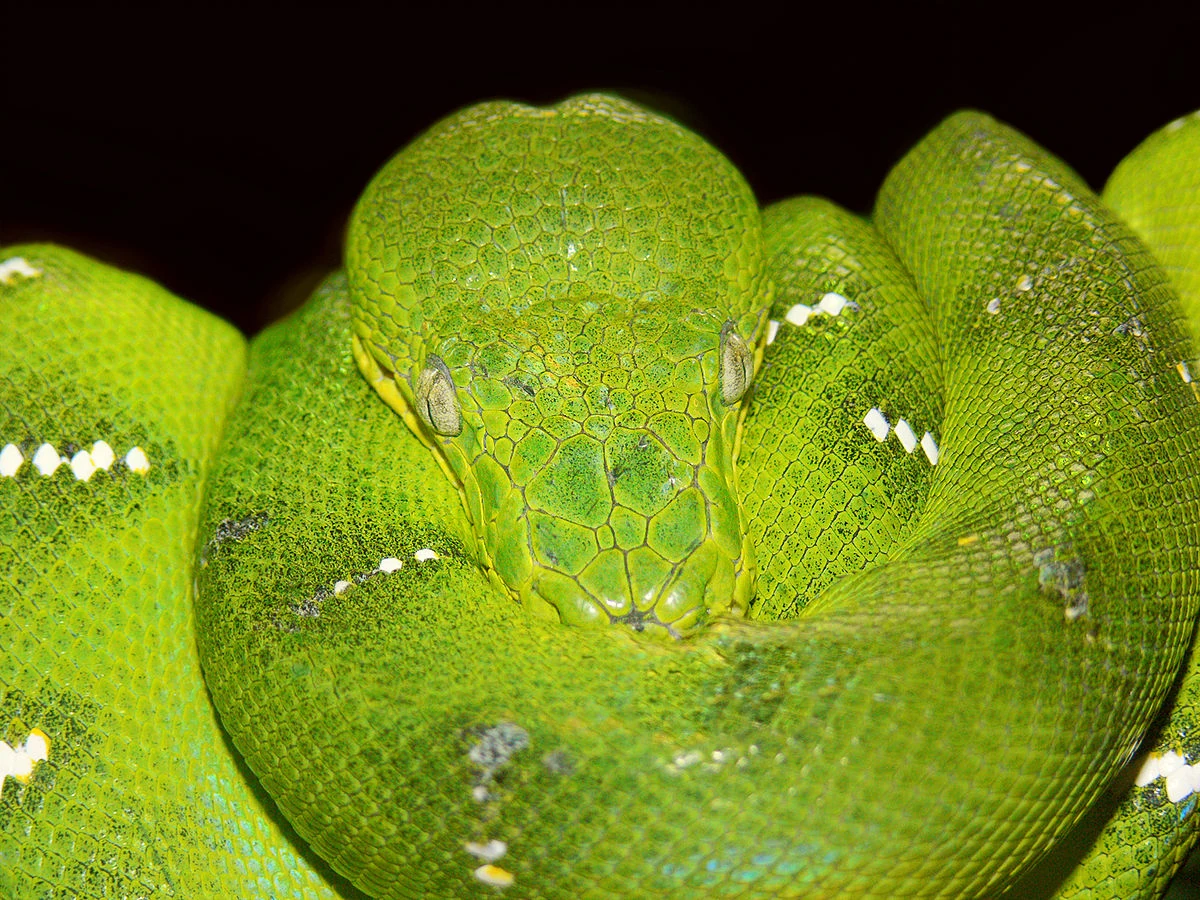Deep within the lush canopies of tropical forests, an extraordinary reptilian lifestyle unfolds far above the forest floor. Unlike their ground-dwelling cousins, certain snake species have evolved to spend their entire lives among the branches, never needing to descend to earth. These remarkable arboreal specialists represent one of nature’s most fascinating evolutionary adaptations. From their uniquely designed bodies to their specialized hunting techniques, tree-dwelling snakes have mastered life in the three-dimensional world of the forest canopy. Their story is one of perfect adaptation, showcasing how evolution has crafted creatures perfectly suited to their ecological niches.
The True Arboreal Specialists: Green Tree Pythons and Emerald Tree Boas
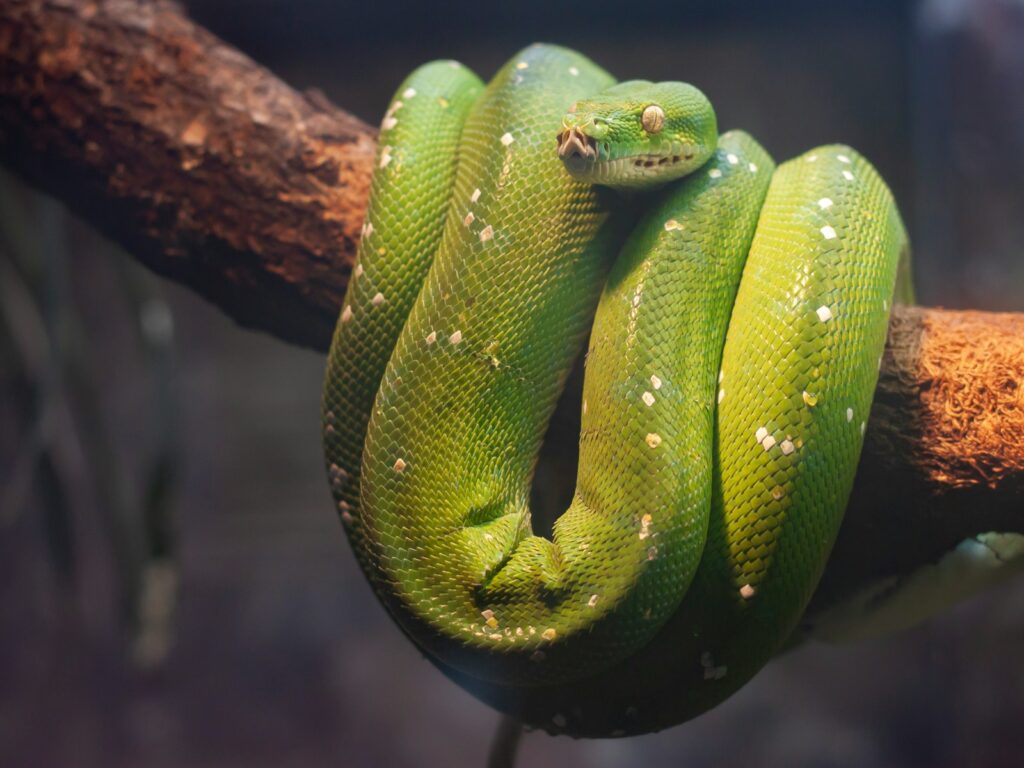
When discussing snakes that live their entire lives in trees, two species stand out as nature’s most committed arboreal specialists: the Green Tree Python (Morelia viridis) and the Emerald Tree Boa (Corallus caninus). Despite evolving on opposite sides of the world—the python in Australia and New Guinea and the boa in South America—these snakes have developed remarkably similar appearances and behaviors through convergent evolution. Both sport a brilliant green coloration that provides perfect camouflage among the leaves, and both possess a specialized body shape with a slender build and longer teeth adapted for capturing birds. Perhaps most distinctive is their characteristic resting position: coiled on branches with their heads resting in the center, creating a saddle-like shape that has become iconic among herpetologists and wildlife enthusiasts alike.
Evolutionary Adaptations for Arboreal Life
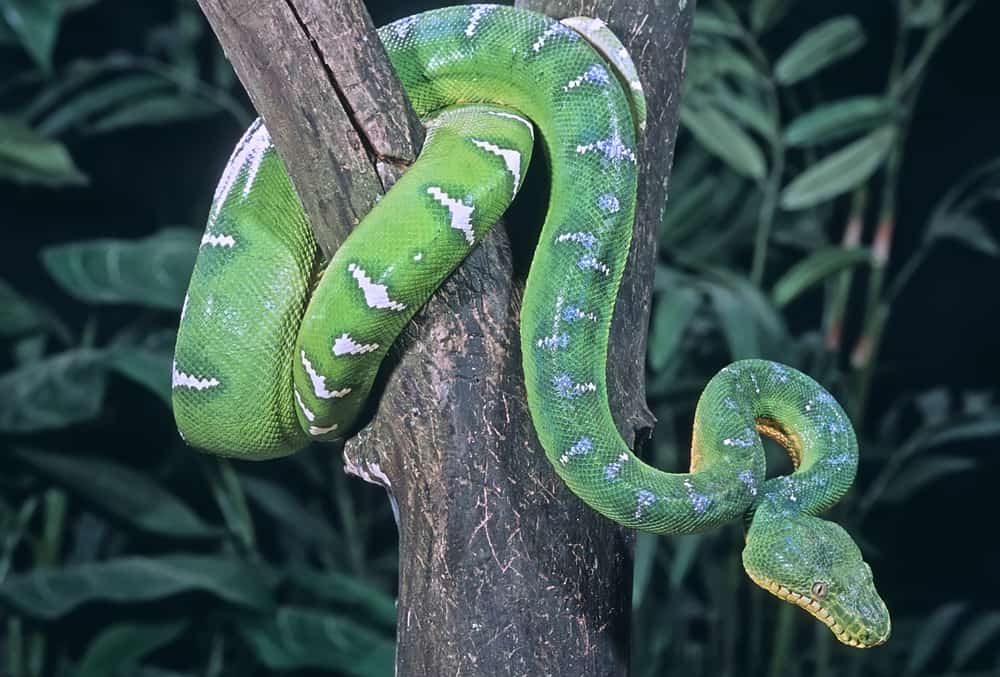
Life in the trees has shaped these snakes’ bodies in remarkable ways over millions of years. Their muscular prehensile tails function essentially as a fifth limb, allowing them to anchor themselves securely while reaching for prey or navigating between branches. The scales on their bellies are often modified with slight ridges or keels that provide better grip on smooth bark and branches. Many arboreal species have developed laterally compressed bodies—flattened from side to side rather than top to bottom—which improves balance and reduces the profile visible to potential prey or predators when viewed from below. Perhaps most impressive are their eyes, which are typically larger than those of ground-dwelling relatives, positioned more forward on the head for improved binocular vision necessary for judging distances when striking at prey across gaps in the canopy.
The Remarkable Hunting Strategy of Arboreal Ambush Predators

Tree-dwelling snakes have mastered the art of patience as ambush predators in a three-dimensional environment. Species like the Green Tree Python may remain motionless in their characteristic coiled position for days, waiting for the perfect moment to strike. Using specialized heat-sensing pits along their lips, these snakes can detect the body heat of nearby birds or mammals even in complete darkness. When prey comes within range, the snake launches with astonishing precision, striking distances of up to two-thirds of its body length in some species. After capturing prey with their long, recurved teeth, they use their powerful coils to constrict the animal before consuming it whole. This hunting strategy minimizes energy expenditure and exposure to their own predators, making it perfectly suited to life in the trees.
From Birth to Death: A Complete Lifecycle in the Canopy

For truly specialized arboreal species, every stage of life unfolds entirely in the trees. Even reproduction has adapted to the challenges of arboreal living, with mating taking place on branches where males must carefully maneuver to avoid falls while pursuing females. Most arboreal species are ovoviviparous, meaning mothers retain eggs inside their bodies until they hatch, giving birth to live young rather than laying eggs that would require ground nesting. When born, the young snakes are immediately equipped with the instincts and physical adaptations needed for tree life, including functional prehensile tails and the innate ability to balance on branches. Fascinatingly, juvenile Green Tree Pythons are born bright yellow or red, providing camouflage in the dappled light of the lower canopy where they typically begin life before developing their adult green coloration as they mature and move higher into the forest.
Dietary Specialization Among the Branches
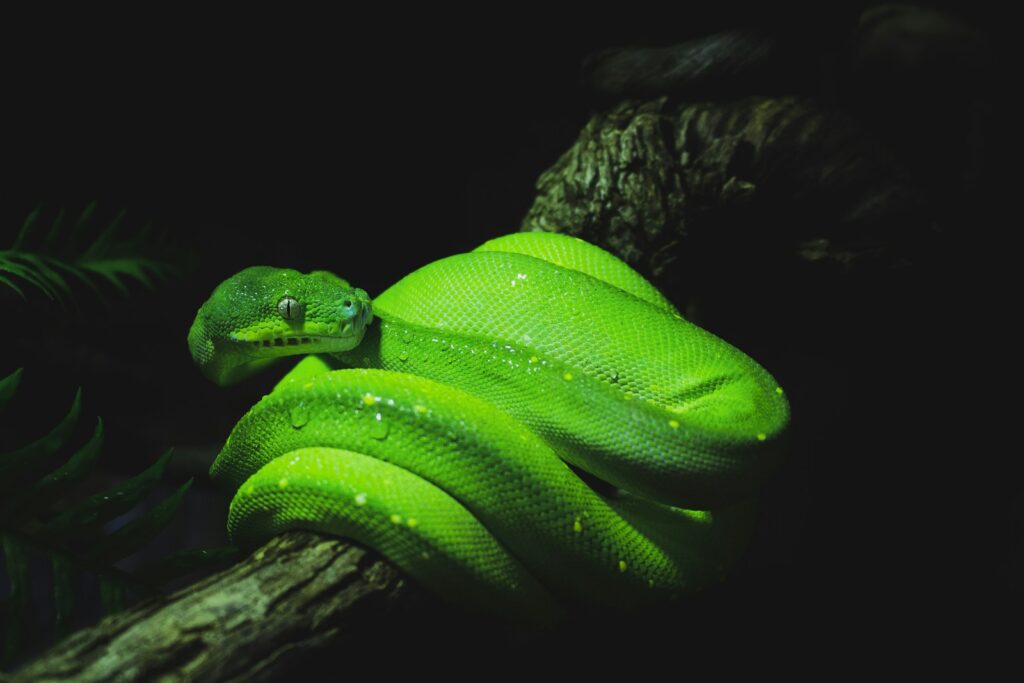
Life in the trees has led to highly specialized diets that differ significantly from those of terrestrial snakes. While ground-dwelling species often feed on rodents and other land-based prey, arboreal snakes have developed preferences for the creatures that share their aerial habitat. Birds and their eggs form a substantial part of the diet for many tree-dwelling species, with specialized adaptations for capturing these quick and alert prey items. Some smaller arboreal snakes specialize in capturing lizards that also inhabit the canopy, while others may feed on bats they ambush near roosting sites. Frogs that live in bromeliads and other canopy plants provide another food source, allowing these specialized predators to find all the nutrition they need without ever descending to the forest floor.
Masters of Disguise: Camouflage in the Canopy
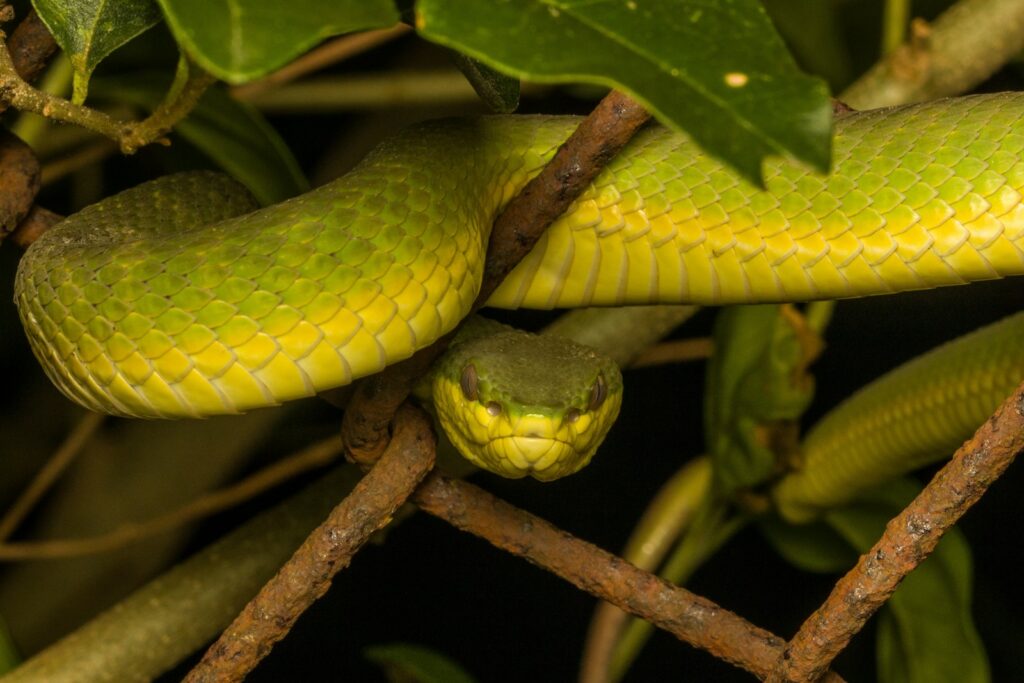
Perhaps the most visually striking adaptation of tree-dwelling snakes is their extraordinary camouflage. The Vine Snake (Oxybelis fulgidus) of Central and South America demonstrates this perfectly with its slender body and pointed snout that mimics a vine tendril so effectively that even experienced naturalists can overlook them. The Asian Vine Snake (Ahaetulla prasina) takes this mimicry further with a body that sways gently in the breeze, matching the movement of surrounding vegetation. Beyond green species, some arboreal snakes like certain members of the Imantodes genus resemble dead twigs or branches, complete with irregular patterns that mimic bark textures and lichen growth. This sophisticated camouflage serves dual purposes: concealing them from predators like eagles and hawks while making them nearly invisible to potential prey until it’s too late.
Geographic Distribution of Tree-Dwelling Specialists

Fully arboreal snakes achieve their greatest diversity in the tropical rainforests of South America, Southeast Asia, and Oceania, where the complex, multi-layered forest canopies provide abundant ecological niches. The Amazon Basin alone hosts dozens of specialized tree-dwelling species, including the Amazon Tree Boa (Corallus hortulanus) and various vine snakes. In Southeast Asia, the paradise tree snakes (Chrysopelea species) have developed perhaps the most extreme adaptation for canopy life: the ability to flatten their bodies and glide considerable distances between trees. Africa’s rainforests host their own arboreal specialists, including the spectacular Rhinoceros Viper (Bitis nasicornis), which, while not exclusively arboreal, spends significant time hunting in low vegetation and shrubs. The geographic distribution of these specialists closely follows the world’s most structurally complex forests, where three-dimensional living spaces reach their maximum development.
The Flying Snakes: Ultimate Arboreal Adaptation
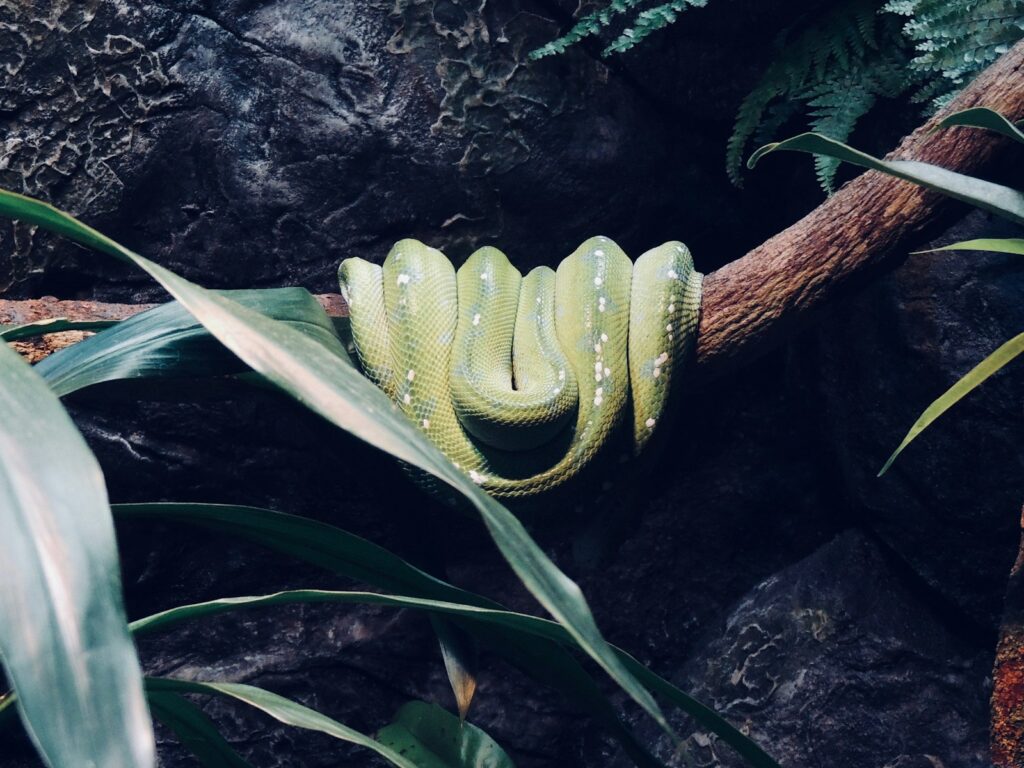
Paradise flying snakes (Chrysopelea) represent perhaps the most extraordinary adaptation to tree-dwelling life, having developed the ability to glide through the air between trees. When preparing to “fly,” these remarkable reptiles climb to a high branch, dangle from the edge, and then launch themselves with a J-shaped motion. Once airborne, they flatten their entire bodies by spreading their ribs, effectively transforming their cylindrical form into a concave wing. By undulating in a distinctive S-shaped motion and making subtle adjustments to the curvature of their bodies, they can actively control their glide path, sometimes covering distances of up to 100 meters while losing relatively little height. This remarkable ability allows them to escape predators, travel efficiently through the canopy without descending, and access new hunting territories—all without ever touching the ground.
Social Behavior and Communication in the Canopy
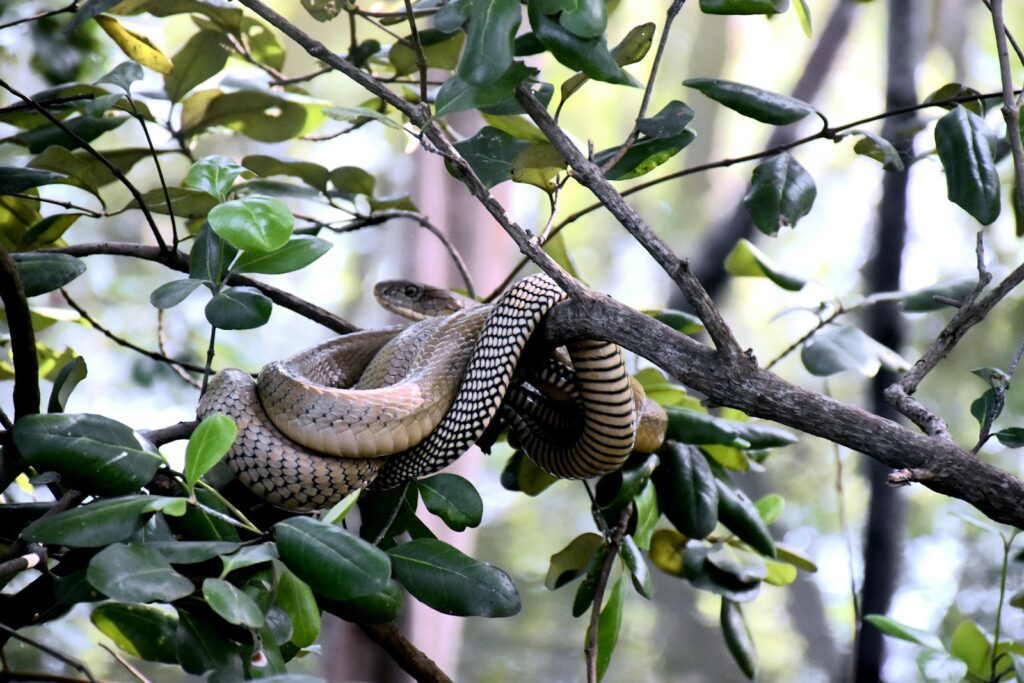
While snakes are generally considered solitary animals, research has revealed that arboreal species sometimes exhibit more complex social behaviors than previously thought. Some tree-dwelling species show preferences for specific perching sites, returning to the same branches repeatedly and potentially leaving chemical signals for other snakes. During mating season, male Green Tree Pythons have been observed engaging in combat rituals that involve intertwining their bodies while attempting to push each other off branches—a specialized form of competition adapted to their three-dimensional habitat. Chemical communication plays a crucial role in the canopy, where visibility may be limited by dense foliage. Females release pheromone trails that males can follow across branches and gaps, allowing them to locate potential mates across the complex arboreal landscape.
Threats to Arboreal Snake Species

Despite their specialized adaptations and seemingly secure canopy homes, arboreal snakes face significant threats in the modern world. Deforestation represents the most immediate danger, with tropical forests being cleared at alarming rates for agriculture, logging, and development. Unlike some ground-dwelling animals that might flee to adjacent habitats, tree specialists lose both their home and their ecological niche when forests are destroyed. The exotic pet trade has placed additional pressure on certain species, particularly the visually striking Green Tree Python and Emerald Tree Boa, which command high prices in international markets. Climate change poses another insidious threat, as rising temperatures and changing precipitation patterns alter the forest microclimate these specialized reptiles have evolved to inhabit. Conservation efforts focused specifically on preserving canopy ecosystems and their specialized inhabitants are becoming increasingly urgent.
Scientific Research and Canopy Exploration
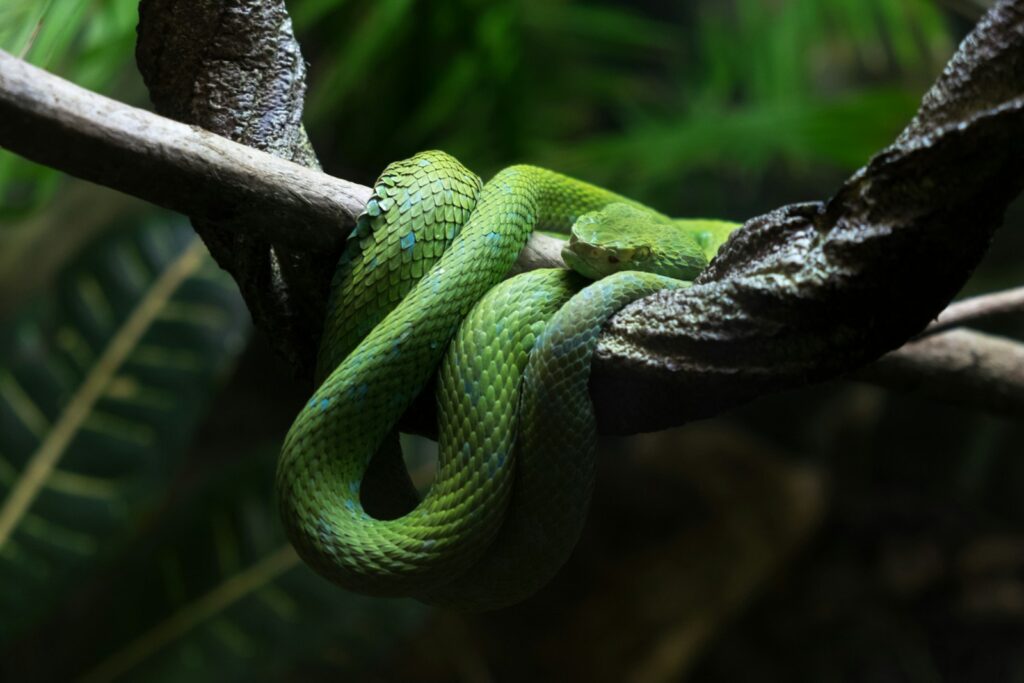
Studying snakes that never leave the treetops presents unique challenges that have only recently begun to be overcome with advances in canopy access techniques. Researchers now employ methods like rope-based climbing systems, canopy walkways, and even construction cranes to access the upper levels of forests where many arboreal specialists spend their lives. Remote sensing technologies, including specialized cameras and environmental DNA sampling, are providing new insights into the population dynamics and behaviors of these elusive reptiles. Radio telemetry studies, where tiny transmitters are carefully attached to snakes, have revealed surprising information about their movements and home ranges within the three-dimensional forest environment. These research efforts continue to uncover new aspects of arboreal snake biology, including previously unknown species that may spend their entire lives in unexplored sections of the upper canopy.
Arboreal Snakes in Indigenous Cultures and Mythology

Tree-dwelling snakes have captured human imagination for millennia, featuring prominently in the mythology and cultural practices of indigenous peoples living near tropical forests. In many Amazonian cultures, the Emerald Tree Boa is considered a powerful spirit animal, representing the connection between the sky world and the forest. Some Papua New Guinea highlands tribes view the Green Tree Python as an ancestral spirit, incorporating its distinctive coiled posture into ceremonial dances and art. In parts of Southeast Asia, the gliding ability of flying snakes has inspired legends of supernatural serpents that patrol the boundaries between the physical and spiritual worlds. These cultural connections often led to traditional conservation practices that protected forests and their arboreal inhabitants long before modern conservation science recognized their ecological importance, demonstrating how indigenous knowledge and scientific understanding can complement each other in preserving these remarkable specialists.
The world of snakes that spend their entire lives in trees represents one of nature’s most specialized evolutionary paths. From their perfectly adapted bodies to their sophisticated hunting strategies, these reptiles demonstrate the remarkable specificity that can develop when a lineage commits fully to a particular ecological niche. As research continues to unlock the secrets of the forest canopy, our understanding of these arboreal specialists continues to deepen, revealing ever more complex and fascinating aspects of their biology. Yet their future remains inextricably linked to the fate of the world’s tropical forests, making them not just evolutionary marvels but also important indicators of ecosystem health in some of our planet’s most biodiverse environments. Through continued research, conservation, and appreciation of these remarkable creatures, we can help ensure that these serpentine tree-dwellers continue their aerial lifestyle for generations to come.

